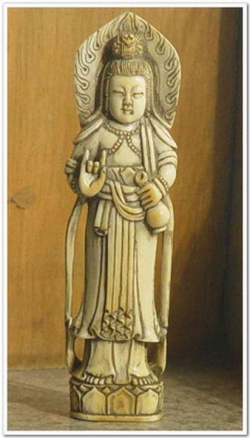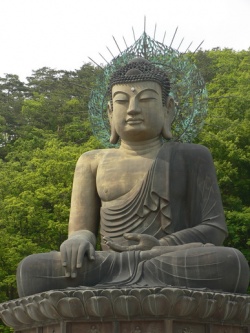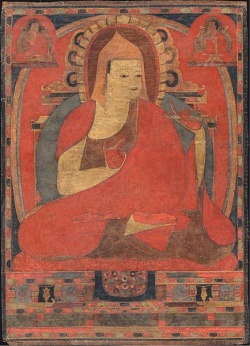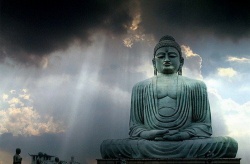Kadam
The order of Tibetan Buddhism founded in the eleventh century by Atisha, Dromtönpa and their followers, the "Kadampa geshes"; the forerunner of the Gelug School, whose members are sometimes called the New Kadampas.
The Kadampa (Tibetan: བཀའ་གདམས་པ་, Wylie: Bka' gdams pa) tradition was a Tibetan Mahayana Buddhist school. Dromtönpa, a Tibetan lay master and the foremost disciple of the great Indian Buddhist Master Atisha (982-1054), founded it and passed three lineages to his disciples.
The Kadampa were quite famous and respected for their proper and earnest Dharma practice.
The most evident teachings of that tradition were the teachings on Bodhicitta (later these special presentations became known as Lojong (Blo-ljong)) and Lamrim (Stages of the Path) by Atisha.
Kadampa A Tibetan word in which ‘Ka’ means ‘word’ and refers to all Buddha’s teachings, ‘dam’ refers to Atisha’s special Lamrim instructions known as the ‘stages of the path to enlightenment’, and ‘pa’ refers to a follower of Kadampa Buddhism who integrates all the teachings of Buddha that they know into their Lamrim practice.
Kadam lineages
After the death of Atisha (1054) his main disciple Lama Dromtonpa (Drom-tön Gyal-we Jungne, 1005–1064) organized his transmissions into the legacy known as "The Four Divinities and Three Dharmas" - a tradition whereby an individual practitioner could perceive all doctrines of the Sutras and Tantras as
non-contradictory and could personally apply them all as complementary methods for the accomplishment of enlightenment.
Eventually this lineage came to be known as Atisha's Kadam Tradition, the Marvellous Legacy of Seven Divine Dharmas.
Lama Dromtonpa transmitted the various lineages of Atisha by dividing them between The Three Noble Brothers.
To one he gave the scriptural traditions,
to the second the oral transmissions, and
to the third the pith instructions.
The Three Noble Brothers are: Geshe Potowa (Potowa Rinchen Sal), Geshe Chenngawa (Chengawa Tsultrim Bar) and Geshe Phuchungwa (Phuchungwa Shönu Gyaltsen).
Dromtonpa founded Reting Monastery (Wylie: Rwa-sgreng) in 1056 in Reting Tsampo Valley north of Lhasa, which was thereafter the seat of the lineage.
The nearby Phenpo Chu and Gyama Valleys were also home to Kadampa monasteries.
Scriptural traditions lineage
Geshe Putowa (1031–1106) received the transmission and responsibility to hold the teachings of the scriptural traditions,
the six Kadampa treatises and hidden verbal transmission of both sutra and tantra from Dromtonpa.
The six Kadam treatises he held are:
- The Bodhisattva Stages (Sanskrit (Skt). Bodhisattvabhumi) by Asanga
- An Ornament of the Mahayana Sutras (Skt. Mahayanasutraalamkara) by Maitreya/Asanga
- A Compendium of Bodhisattva Trainings (Skt. Shikshasamucchaya) by Shantideva
- A Guide to the Bodhisattva Way (Skt. Bodhisattvacharyavatara) by Shantideva
- A Garland of Birth Stories (Skt. Jatakamala) by Aryadeva, and
- The Collected Sayings of the Buddha (Skt. Udanavarga) - the Tibetan Dhammapada by Dharmatrata.
It is the tradition to read at the Great Prayer Festival (Monlam) the fifth of these, A Garland of Birth Stories, during the morning session.
It was also the tradition of the Kadampas to teach the two texts Jatakamala and Udanavarga together and when they taught Shantideva's Bodhisattvacharyavatara they taught the Shikshasamucchaya too.
The scriptural traditions were of two main types: those dealing with ultimate reality and the wisdom of emptiness;
and those dealing with conventional reality and the vast Bodhimind (Skt. Bodhicitta) activities.
The six Kadam treatises were mainly used to elucidate the nature of the bodhisattva's vast activities.
Those dealing with the ultimate wisdom of emptiness, the principal texts stressed here were Nagarjuna's six treatises on emptiness philosophy, such as The Root of Wisdom (Skt. Mulamadhyamakakarika) and so forth,
together with the commentaries to them by the later Indian masters; and also Atisha's own commentaries on the middle view and on the nature of the two truths. These were the principal scriptures studied in the Old Kadam School.
Oral transmissions lineage
Geshe Chenngawa (Chengawa Tsultrim Bar) received the transmission and responsibility to hold the oral tradition of instructions (oral transmission).
These teachings were mainly dealing with the Four Noble Truths.
One of his students, Jayulwa, inherited a special practice lineage which was called Chenga Kague and became a part of the Dagpo Kagyu lineage.
Pith instructions lineage
These oral tradition teachings are generally known as The Instructions for Training the Mind in the Mahayana Tradition (Tibetan, Theg-chen-blo-sbyong-gi-gdampa-pa).
According to the 1st Dalai Lama Atisha had received three lines of Lojong transmission, but there are conflicting accounts of from whom.
It is agreed that he received teachings in Sumatra, Indonesia, from a master called Serlingpa (Wylie: gSer-gling-pa) by Tibetans.
It is also agreed that he received teachings from a master named Dharmarakshita.
However, sometimes Serlingpa is identified as Dharmamati of Suvarnadvipa, and sometimes as Dharmarakshita.
In the former case, Dharmarakshita is identified as a scholar at the monastic university of Odantipuri.
The final main Lojong teacher is the Indian master Maitriyogi.
Atisha secretly transmitted them to his main disciple, Lama Dromtonpa.
During the time of The Three Noble Kadampa Brothers many of these oral teachings were collected together and compiled into the text Stages of the Doctrine (Lamrim; tib.: sTan-rim).
Yet at the time the lineages from Atisha’s Indonesian master Dharmakirti (the Lojong - Teachings on how to train in Bodhichitta) were still kept secret.
When the time was sufficiently mature, the Lojong Teachings were publicly revealed.
First Geshe Kham Lungpa published Eight Sessions for Training the Mind (Tib., bLo-sbyong-thun-brgyad-ma), then Geshe Langri Tangpa (1054–1123) wrote Eight Verses for Training the Mind (Tib., bLo-sbyong-tshig-brgyad-ma).
After this, Sangye Gompa composed A Public Explanation (Tib., Tshogs-bshad-ma) and Geshe Chekhawa (1102–1176) wrote Seven Points for Training the Mind (Tib., bLo-sbyong-don-bdun-ma).
In this manner, the Lojong Oral Transmission Teachings gradually emerged and became known to the public.
Before being revealed, the secret lineage was as follows:
Dharmarakshita-> Atisha-> Dromtonpa -> Potowa -> Sharawa (1070–1141) -> Chekhawa (1101–1175).
From Khamlungpa, Langri Tangpa and Chekhawa onwards they became public and later they were integrated into all four Tibetan Buddhist Schools.
(These Kadampa-Lojong texts were brought together into the anthology A Hundred Texts on Training the Mind (Tib. bLo-byong-brgya-rtsa)).
Atisha's legacy
Je Atisha had three chief students.
Besides the famous Dromtonpa (Drontön Gyalwe Jungne), who established the Radreng monastery, there were Khu (Khutön Tsöndru Yungdrang) and Ngok (Ngok Legpe Sherap).
Ngok established the dharma center of Sangphu Neuthok and this institute was later developed further by his nephew, the translator, Ngok Loden Sherap and it became the source of all the Tibetan centers for advanced study (Shedra).
Ngatso Lotsawa Tsultrim, a translator who brought Atisha to Tibet, and served him for 19 years was another important student of Atisha.
Ngatso Lotsawa Tsultrim received teachings from Atisha, Jnana Akara and others, and his main lineage is called the Ngatso Kagyu.
It is said in the Tibetan Tradition of Buddhism that the holder of the Kadam lineage have their bodies adorned with the four deities
(Shakyamuni,
Avalokiteshvara,
Tara and
Achala),
their speech adorned with the three Pitakas (Vinaya, Sutra, Abhidharma) and their minds adorned with the practice of the three trainings
(ethical discipline,
meditation and
wisdom).
It is said the Kadampas practiced Seven Divine Dharmas: The four deities and the three trainings of the three pitakas.
The Kadampas mainly emphasised the Sutra path (the union of compassion and wisdom).
In general it can be stated the teachings of the Kadampas are upheld by the four schools of Tibetan Buddhism.
Later developments
Je Tsongkhapa(Btsong-ka-pa) a reformer, collected all the three Kadam lineages and integrated them, along with Sakya, Kagyu and other teachings, into his presentation of the doctrine.
The pervasive influence of Tsongkhapa was such that the Kadampas that followed were known as "New Kadampas" (Tib. Sarma Kadampa) or, more commonly, as the Gelug school, while those who preceded him became retroactively known as "Old Kadampas," or simply as "Kadampas."
The Kadam tradition ceased to exist as an independent tradition by the end of the 16th century.
One of the most important sayings of the Kadam masters is said to be
New Kadampa Tradition
- See also :
- See also :
[[File:Geshe_Kelsang_Gyatso.jpg|thumb|250px|Kelsang Gyatso)] To emphasize that he was training in the same spirit as Atisha's original disciples, Je Tsongkhapa named his school "the New Kadampa" (Tib. Kadam Sarma). In 1991, Kelsang Gyatso (Bskal-bzang Rgya-mtsho), a Buddhist monk trained at Sera Monastery, a Gelug university in Je Tsongkhapa's tradition, founded a spiritual organization which he named the "New Kadampa Tradition - International Kadampa Buddhist Union" (NKT-IKBU).
As mentioned above, Je Tsongkhapa referred to his monastic order as "the New Kadam." The term Gelug came into use only after his death. The NKT-IKBU explains that they are independent of other contemporary Tibetan Buddhist centers and Tibetan politics, although they are in the same tradition as the Gelugpas (i.e., New Kadampas). They explain that the purpose of using the term "Kadampa Buddhism" is not to introduce confusion about the origins of these teachings, but to encourage students to emulate the purity and sincerity of the ancient Kadampas.



